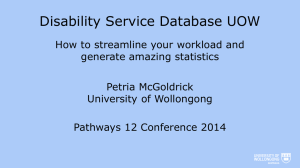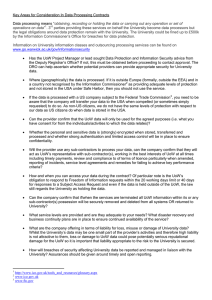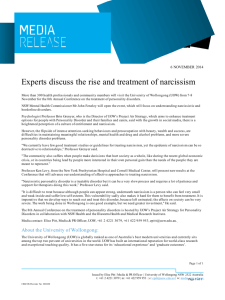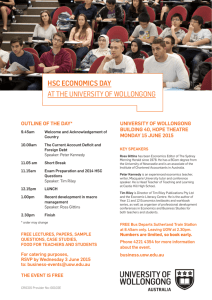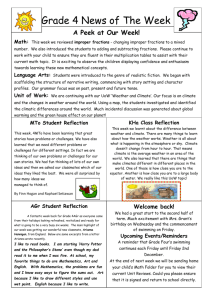energy savings action plan 2014 – 2018
advertisement
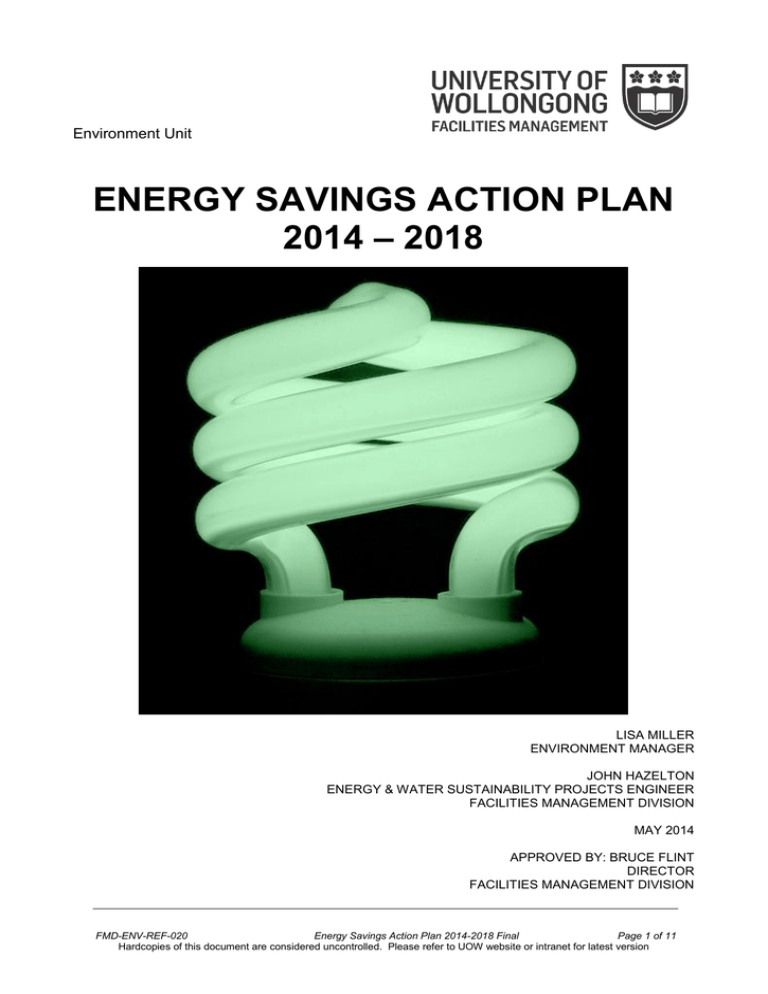
Environment Unit ENERGY SAVINGS ACTION PLAN 2014 – 2018 LISA MILLER ENVIRONMENT MANAGER JOHN HAZELTON ENERGY & WATER SUSTAINABILITY PROJECTS ENGINEER FACILITIES MANAGEMENT DIVISION MAY 2014 APPROVED BY: BRUCE FLINT DIRECTOR FACILITIES MANAGEMENT DIVISION FMD-ENV-REF-020 Energy Savings Action Plan 2014-2018 Final Page 1 of 11 Hardcopies of this document are considered uncontrolled. Please refer to UOW website or intranet for latest version Contents 1 2 3 Executive Summary ........................................................................................................................ 3 Introduction...................................................................................................................................... 4 Energy Savings Action Plans .......................................................................................................... 5 3.1 Renewable Energy .................................................................................................................. 8 3.2 Existing Onsite Solar PV ......................................................................................................... 8 3.3 Financial Strategy ................................................................................................................... 9 4 2014 - 2018 ESAP .......................................................................................................................... 9 5 2014 – 2018 ESAP Projects.......................................................................................................... 10 5.1 Wollongong Campus ............................................................................................................. 10 5.2 Shoalhaven Campus ............................................................................................................. 10 5.3 iC ........................................................................................................................................... 10 5.4 Regional Campuses .............................................................................................................. 10 6 Version Control Table ................................................................................................................... 11 FMD-ENV-REF-020 Energy Savings Action Plan 2014-2018 Final Page 2 of 11 Hardcopies of this document are considered uncontrolled. Please refer to UOW website or intranet for latest version. 1 Executive Summary The largest direct environmental impact and contributor to greenhouse gases at the University of Wollongong (UOW) is from its combined energy consumption via electricity and gas. Electricity is by far the greatest contributor to energy use and carbon dioxide equivalent (CO 2-e) emissions. An analysis of UOW’s energy consumption is presented in this paper, as well as a new plan to reduce consumption over the next five years. A key requirement of the over-arching UOW Environmental Management Plan 2014-2016 (Energy Management) is to prepare an Energy Savings Action Plan. Electricity costs UOW some $6.5 million per annum, and gas a further $400,000. This cost has increased significantly over the last five years. In an effort to reduce the environmental impact and minimise an operational cost, the Environment Unit has developed a 2014-2018 Energy Savings Action Plan (ESAP) that will provide carbon reductions and cost savings in the medium- to long-term, and establish an on-site renewable programme. The hierarchy of cost vs benefit in the energy sector is summarised in the following: Behaviour Change ‘Shutting Down and Switching Off’ Policy, Design Guidelines Least Cost – Maximum Benefit Infrastructure Change Retrofitting for Energy Efficiency Voltage Reductions Air-conditioning Optimisation Renewable Energy In 2005, the NSW Government passed legislation, Energy and Utilities Administration Act 1987, to mandate all large businesses in the State to prepare and implement an ESAP. UOW is subject to this legislative requirement. However, the NSW Office of Environment and Heritage recently advised that no further reporting is required on UOW ESAPs by the NSW Government. The 2014-2018 ESAP plans to reduce energy demand during this period. A requirement of the action planning process is to prepare business cases to secure funding for the initiatives identified. This ESAP provides planned target project areas. The final evaluation, planning, funding and implementation of the projects are intended to be achieved under UOW policy, and by utilising the resources of the Environment Unit and the FMD construction and maintenance units. FMD-ENV-REF-020 Energy Savings Action Plan 2014-2018 Final Page 3 of 11 Hardcopies of this document are considered uncontrolled. Please refer to UOW website or intranet for latest version 2 Introduction UOW’s largest direct environmental impact and contribution to the generation of greenhouse gases is from its energy consumption via electricity and gas. Electricity is, by far, the greatest contributor to energy use and carbon dioxide equivalent (CO2-e) emissions. An analysis of UOW’s energy consumption is presented, as well as a new plan to reduce consumption and associated costs over the next five years. Energy consumption on campus alone is not the full extent of costs - Figure 1 outlines the average household breakdown in electricity costs with only about 25% direct use. However, UOW is part of the unregulated market with lower cents per kilowatt charges than the retail regulated sector, increasing the energy costs to around 36.6% of the electricity bill. Therefore, UOW only has direct control of 36.6% of its electricity costs, yet that usage has multiple operational cost impacts. Figure 1: Independent Pricing and Regulatory Tribunal (IPART) Graphic for the Regulated Electricity Industry Billing Breakdown UOW has two competitively tendered electricity contracts - all of the combined large electricity meters, such as its major campuses, and all of the small consumption sites, such as houses in Bowral. Both contracts are currently held by Origin Energy. The large meter contract is divided into peak, off-peak and shoulder for both energy and network charges. Each has slight differences in time of use: Network: o Peak: 1300 - 2000 hours working days. o Shoulder: 0700 - 1300 and 2000 - 2200 working days. o Off-Peak: All other times including Public Holidays. Energy: o Peak: 0700 - 0900 and 1700 – 2000 working days. o Shoulder: 0900 - 1700 and 2000 - 2200 working days. o Off-Peak: All other times including Public Holidays. The other major charge on the large meter sites is the Demand Charge which is currently $15 per kVA for each month’s maximum peak. FMD-ENV-REF-020 Energy Savings Action Plan 2014-2018 Final Page 4 of 11 Hardcopies of this document are considered uncontrolled. Please refer to UOW website or intranet for latest version 0.2 0.18 0.16 0.14 0.12 0.1 0.08 0.06 0.04 0.02 0 2005 2006 2007 2008 2009 2010 2011 2012 2013 Figure 2: Average Cost of Electricity cents/kWh at UOW In 2012, UOW conducted a ‘reverse auction’ on its electricity and gas contracts to minimise costs. This has saved UOW just over $100,000 per annum with the new contract term of 42 months to December 2015. The electricity bill in 2013 was approximately $6.5 million. Gas supply in NSW is reaching a critical phase, with major reserves being largely exported and coal seam gas becoming more dominant on the supply side. In addition, the price is now linked to commodity prices and is predicted to be more volatile in the future. The major consumer of gas at o the Wollongong Campus is the pool. The outdoor pool is heated to a relatively high 28 c all year round. 3 Energy Savings Action Plans In 2005, the NSW Government passed legislation to mandate all large businesses in the State to prepare and implement an ESAP. The plan has to be prepared for five years and a detailed audit is required to set a baseline or benchmark of energy use, against which reductions from actions to reduce consumption could be measured. In 2005, UOW conducted a level 3 audit (including sub-metering) of its energy consumption to allow the preparation of the first ESAP. The audit focussed on the consumption at the Wollongong Campus only and observed the breakdown of energy use across the campus to consist of 64% energy used for heating and cooling, 16% on lighting, 7% on office equipment, 4% on hot water and the remainder on miscellaneous items (refer Figure 3). FMD-ENV-REF-020 Energy Savings Action Plan 2014-2018 Final Page 5 of 11 Hardcopies of this document are considered uncontrolled. Please refer to UOW website or intranet for latest version Breakdown of Total Energy Use by Application in 2005 9% 4% Cooling & Vent 30% 7% Heating Lighting 16% Office Equip Other Equip 34% Hot Water Cooking & Amen Figure 3: Estimated Breakdown of 2005 Energy Consumption on the Wollongong Campus The first ESAP focussed on establishing the framework for reform, employing staff to implement the plan and metering systems to better monitor and manage energy consumption and to verify estimated savings from actions implemented. Key actions 2009 - 2013 included: Environmental & Sustainability Initiatives (ESI) Unit was created to implement environmental and sustainability policies, including energy, water, waste and biodiversity. New Utilities Monitoring and Management System (UMMS) and a Performance Indicator Unit (PIU) System being implemented for sustainability reporting. To date, over 200 electricity and 19 gas sub-meters have been installed, and provide 15 minute and one hour interval data, respectively. A five-year Environmental Management Plan has been established based on goal setting and targets. UOW purchased a 20% Green Power component during the years 2010-2013. Procedures were implemented in the new building development process. Design standards were amended and continuous building review introduced. Review process for new services and systems completed as part of design standards for new buildings and major refurbishments. Maintenance and operational improvements being implemented on a progressive basis together with building by building projects. Lighting retrofit programmes carried out in Buildings 3, 15, 31 and 39 changing from T8 to T5, and LED conversion of the Multi-Storey Carpark. De-lamping corridors in Buildings 4 and 19. HVAC improvement projects have been carried out in Buildings 3, 14, 15, 16, 17, 18, 20, 22, 25, 30, 36, 39, 41 and 67. FMD-ENV-REF-020 Energy Savings Action Plan 2014-2018 Final Page 6 of 11 Hardcopies of this document are considered uncontrolled. Please refer to UOW website or intranet for latest version All viable energy measures in the first ESAP have been actioned and some additional work was completed due to lower costs of, for example, energy-efficient lights. During the first ESAP the Wollongong Campus experienced considerable growth, increasing its population (Effective Fulltime 2 Student Load – EFTSL) and gross floor area (m ). Figure 4 projects savings against a ‘business as 2 usual’ (BAU) scenario - consumption per person and per m , and identify the savings achieved. The NSW Office of Environment and Heritage recently advised that no further reporting is required on UOW ESAPs by the NSW Government. The following timeline shows that UOW has achieved just over 100% of the forecast ESAP savings. 160000 140000 120000 100000 80000 60000 40000 20000 0 Energy Use (BAU by Area) Energy Use (BAU by EFTS) ESAP Target energy Use (GJ) Actual Energy Use (GJ) Base Year 2005 2006 2007 2008 2009 2010 2011 2012 Figure 4: ESAP Savings at Wollongong Campus The majority of energy savings (2009 - 2013) have been achieved through infrastructure changes such as: Time-of-day air-conditioning scheduling (not running the air-conditioning 24/7). Power factor correction. Voltage reductions. Energy-efficient lighting retrofits. De-lamping in over-lit spaces, e.g. corridors. Implementing an energy-efficient heater policy. However, cost-effective savings can also be made through behaviour change – by switching off lights, computers, equipment and appliances. Despite these infrastructure improvements, the electricity consumption at the Wollongong Campus shows a significant base load. That is, UOW consumes 50% of its daily peak load at 2 am (refer Figure 5). A significant portion of this load is due to appliances such as lights and computers that potentially do not need to be left on. This has been tested during ‘Earth Hour’ campaigns where a reduction of between 9 and 37% has previously been recorded in the overnight load by staff and students switching off. To address this ‘behaviour’ issue, a ‘Green Office Programme’ was designed to target staff behaviours around resource use. Since the programme began in June 2012, computer shutdown has significantly increased. FMD-ENV-REF-020 Energy Savings Action Plan 2014-2018 Final Page 7 of 11 Hardcopies of this document are considered uncontrolled. Please refer to UOW website or intranet for latest version 16.0 12.0 10.0 8.0 6.0 4.0 2.0 0.0 00:00 - 00:59 01:00 - 01:59 02:00 - 02:59 03:00 - 03:59 04:00 - 04:59 05:00 - 05:59 06:00 - 06:59 07:00 - 07:59 08:00 - 08:59 09:00 - 09:59 10:00 - 10:59 11:00 - 11:59 12:00 - 12:59 13:00 - 13:59 14:00 - 14:59 15:00 - 15:59 16:00 - 16:59 17:00 - 17:59 18:00 - 18:59 19:00 - 19:59 20:00 - 20:59 21:00 - 21:59 22:00 - 22:59 23:00 - 23:59 Ave. Hourly GJ Consumption 14.0 Figure 5: Wollongong Campus – Summer Day, Averaged Hourly Electrical Energy Consumption Profile 3.1 Renewable Energy After an assessment of other universities in 2008, UOW began purchasing 15% of its energy from renewable sources. This proportion was increased to 20% in 2012 and 2013, at a cost of $303,000 per annum. Up until now, purchasing external renewable energy was the most cost-effective way of reaching renewable energy targets. UOW has demonstrated its commitment to renewable energy. However, with the improvements in renewable energy technology (and the escalating transmission costs), UOW is intending to significantly increase its onsite electricity production. This has the advantage of reducing UOW reliance on the grid and providing some degree of future-proofing. It is also intended that the installation of on-site renewable energy production will provide teaching and research benefits, and demonstrate that UOW is a leader in this field. The history of UOW’s onsite renewables is summarised in the following Table. The Table also outlines the variability over time in pricing of the panels. 3.2 Existing Onsite Solar PV Year Place kWp $/kWp Tariff Supply/Installer 2010 Keiraview (Retrofit) 9.24 $5,602 60 cent gross feed in tariff Solgen 2011 South Coast Workers Child Care (Retrofit) 9.88 $3,492 60 cent gross feed in tariff Energy Matters 2011 SMART (New Build) 4.05 $9,700 none Class Electrical – Construction Electrician for SMART 2012 McKinnon Lawn Refurbishment (Administration) (New Build) 5.89 $7,300 none Blue/Green FMD-ENV-REF-020 Energy Savings Action Plan 2014-2018 Final Page 8 of 11 Hardcopies of this document are considered uncontrolled. Please refer to UOW website or intranet for latest version 3.3 Financial Strategy As UOW had progressed with its investigation of options for on-site electricity production, including a review of similar strategies at other Australian universities, the purchase of “Green” energy for 2014 was not proceeded with by UOW. It is now proposed this funding be utilised to fund the 2014-2018 ESAP projects, outlined in Section 5. The strategy of investing in on-site electricity production is a positive strategy in reducing UOW’s future electricity costs. The electricity cost savings achieved with the successful implementation of each ESAP project potentially frees capital for investment in the next project (provided the business case is viable). 4 2014 - 2018 ESAP UOW (co-ordinated through the FMD Environment Unit) aims to achieve the following: Reduce energy consumption by 5% per annum as per the Environmental Management Plan 2014-2016 Energy Management Target UOW KPI of 0.59 GJ/m 2 . Since the introduction of the Wollongong Campus UMMS, detailed data is available which negates the requirement for another phase 3 audit. The PIU reports identify high energy buildings and focus the ESAP. This has made URAC a priority for reducing energy consumption by implementing more efficient pool heating systems (and possible installation of solar photovoltaic arrays). Audits were conducted by energy consultants, through a grant received from the Office of Environment and Heritage at the Innovation Campus, Shoalhaven Campus and Campus East. These audits identified a range of initiatives which are included in the following Section. Further initiatives at the Wollongong Campus have been identified including time-of-day airconditioning scheduling, voltage optimisation, de-lamping in over-lit spaces and energy-efficient lighting retrofits. Many items such as LED lighting and solar PV are part of new and emerging technologies and are continually reducing in cost and improving in efficiency. This should not delay action but merely highlight that, over the life of the action plan, capital costs of supply and installation may reduce and lifecycle benefits will increase. The rationale for the plan is to combine behaviour change programmes with infrastructure improvement. Behaviour change programmes aimed at shutting down and switching off which have the potential to save the greatest energy and costs, for the least cost to implement. However, these need to be continually reinforced. Infrastructure changes that reduce the load when used and often have a longer life than the products they replace, consequently reducing maintenance costs. The final strategy, once energy efficiency is maximised, is to add a renewable array to further reduce our ecological impacts and operational costs. It is proposed to retrofit solar photovoltaic to campus roofs over the next five years. The following section identifies the target projects, with future detailed planning required to ensure UOW maximises the long term benefit with enhanced sustainability. FMD-ENV-REF-020 Energy Savings Action Plan 2014-2018 Final Page 9 of 11 Hardcopies of this document are considered uncontrolled. Please refer to UOW website or intranet for latest version 5 2014 – 2018 ESAP Projects The following projects have been selected for further evaluation and preparation of detailed business cases, prior to funding being approved. 5.1 Wollongong Campus 1. 2. 3. 4. 5. 6. 7. 8. 9. 10. 11. 5.2 Photovoltaic generation (retrofit one building p.a.) Sustainability/commissioning audit of selected buildings (one building p.a.). Building LED retrofit (two buildings p.a. - 3,000 tubes). Lux assessments and de-lamping (250 tubes p.a.). HVAC review and maintenance (ongoing). Sub-station voltage optimisation. Time-clock replacement with PE-cells for external lighting. Trial LED/induction conversion of external lighting. Green Office Programme and office infrastructure improvements. Sustainable retrofit identification and implementation. Pool solar heating. Shoalhaven Campus 1. Hot water unit – solar/gas for canteen. 2. Hot water unit– solar/gas for all amenities. 3. Retrofit external lights with energy efficient. 5.3 iC 1. 2. 3. 4. 5. 6. 7. 8. 5.4 Reduce density of external lights as new areas are developed. Direct ventilation of furnaces in AIIM Building. Replace incandescent lights in Planetarium with LEDs. Improve energy efficiency in Planetarium exhibit. Replace T8s with LEDs. Software upgrade for automated PC switch-off. Replace electric hot water systems with gas. Voltage reduction units in car park and fire stairs. Regional Campuses 1. Conduct Energy Audits, and assess energy reduction projects. FMD-ENV-REF-020 Energy Savings Action Plan 2014-2018 Final Page 10 of 11 Hardcopies of this document are considered uncontrolled. Please refer to UOW website or intranet for latest version 6 Version Control Table Version Control 1 Release Date 20140130 2 20140129 3 20140402 4 20140502 5 20140516 Author/Reviewer Approved By Amendment Lisa Miller, Environment Manager Bruce Flint, Director Facilities Management Division Energy Savings Action Plan created Bruce Flint, Director Facilities Management Division Bruce Flint, Director Facilities Management Division Bruce Flint, Director Facilities Management Division Bruce Flint, Director Facilities Management Division Minor amendments after general consultations Minor amendments after further consultation CAO comments incorporated John Hazelton, Energy & Water Sustainability Projects Engineer John Hazelton, Energy & Water Sustainability Projects Engineer John Hazelton, Energy & Water Sustainability Projects Engineer John Hazelton, Energy & Water Sustainability Projects Engineer John Hazelton, Energy & Water Sustainability Projects Engineer EAC comments incorporated FMD-ENV-REF-020 Energy Savings Action Plan 2014-2018 Final Page 11 of 11 Hardcopies of this document are considered uncontrolled. Please refer to UOW website or intranet for latest version
